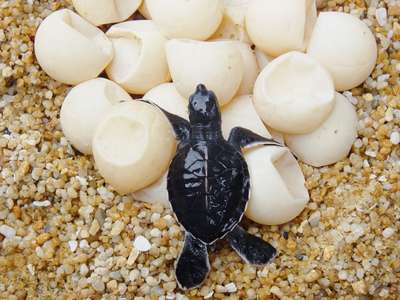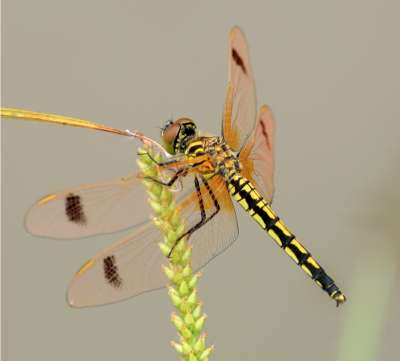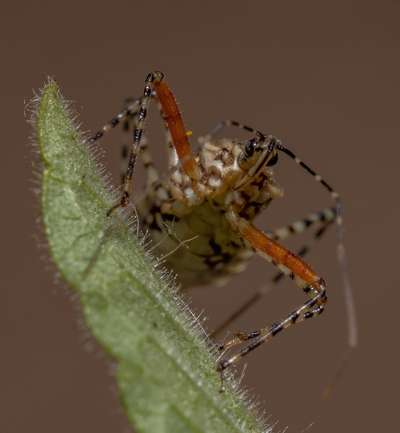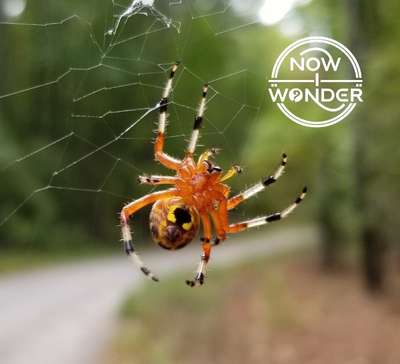The Painted Lady butterfly (Vanessa cardui) visits North Carolina during the summer months from its year-round habitat in northern Mexico, then flees south in the fall before the first hard frost. Although widely distributed across the state, individuals are never very common in North Carolina.
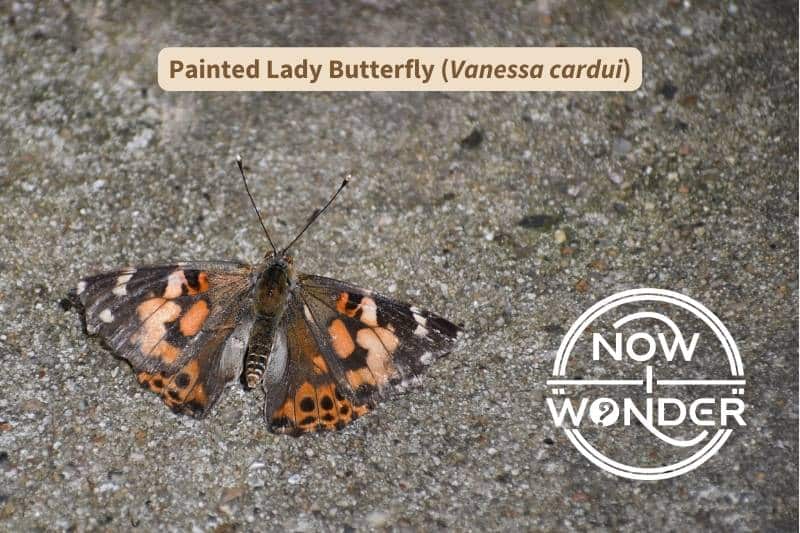
Fun Facts about Painted Lady Butterflies to Wow Your Friends
My absolute favorite thing to do after I identify a butterfly is to learn everything I can about it.
Every species on earth is unique and has its own quirks, hidden talents, enemies, and friends. I call these special tidbits “fun facts” because that’s what they are to me.
Here are a few fun facts about Painted Lady butterflies that I hope you enjoy too!
- The Painted Lady butterfly (Vanessa cardui) has the broadest global distribution of any known butterfly (Glassberg, 1999). Individuals can be found throughout the world on every continent except in South America and Antarctica.
- This species is also commonly called the “Cosmopolitan” butterfly because of its worldwide distribution.
- Adult Painted Lady butterflies in the Eastern Hemisphere participate in the longest round-trip seasonal migration of any insect species currently known (Stefanescu et al. 2023), including that of the famous Monarch butterfly (Danaus plexippus) here in the United States.
- Succeeding generations of Painted Ladies migrate south from areas as far north as Scandinavia to sub-saharan Africa in the fall (usually around September) and back again in the spring (usually around March) (Cuadrado, 2021).
- Six generations participate in the migratory cycle (Stefanescu et al., 2013).
- Each one-way leg covers many thousands of kilometers and up to 60 degrees of latitude (Stefanescu et al., 2013).
- In contrast, the migration of eastern North American Monarchs covers only approximately 30 degrees of latitude, from the northeastern United States south to the central Mexican state of Michoacan.
- When migrating, Painted Lady butterflies fly in a set direction and in a very determined way. They don’t stop for food and they don’t change their course to avoid obstacles. If a tall building looms in their path, they will fly over it, rather than around it (Shapiro, 2007).
- Painted Lady butterfly caterpillars are “arguably the most polyphagous butterfly species in the world” (Janz, 2005). Instead of specializing on only a particular family of plants like many specialist feeder butterfly species, these caterpillars are generalist feeders and consume plants from dozens of different families.
- Adult Painted Lady butterflies (Vanessa cardui) are beautiful but the caterpillars can be serious pests of corn, alfalfa, sunflowers, beans, and soybeans (Kelly and Debinski, 1999) when present in large numbers.
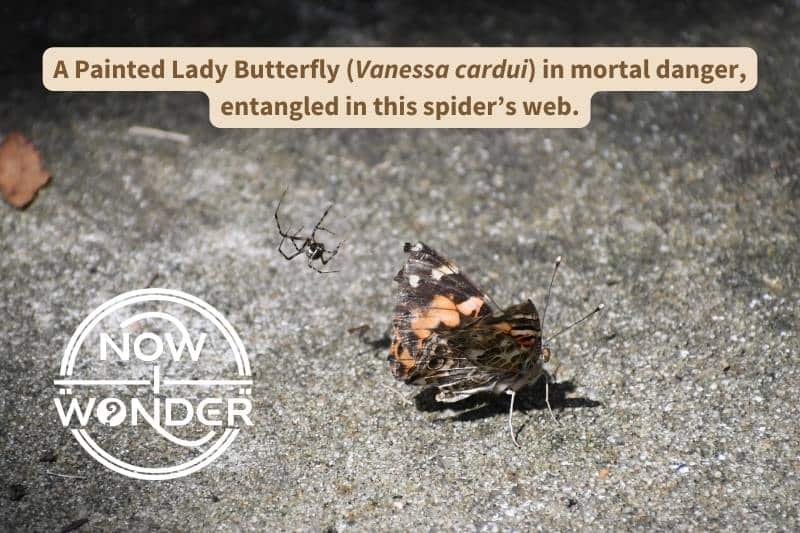
But fun facts are a whole lot more fun when you get to see the actual animal in real life. So read on to find out where, when, and how to find Painted Lady butterflies, and how to make sure you’re looking at the animal you think you are. You’ll be so glad you did!
How Are Painted Lady Butterflies Classified?
| Kingdom | Animalia |
| Phylum | Arthropoda |
| Class | Insecta |
| Order | Lepidoptera |
| Family | Nymphalidae (“brushfoot” butterflies, subfamily Nymphalinae “true brushfoots”) |
| Genus species | Vanessa cardui |
How Do I Know I’m Looking At a Painted Lady Butterfly?
Appearance of Painted Lady Butterfly Eggs
Painted Lady butterfly (Vanessa cardui) eggs are pale green and barrel-shaped (Pyle, 1981). The females lay the eggs one at a time on the leaves of an unusually large variety of host plants.
Appearance of Painted Lady Butterfly Caterpillars / Larvae
Painted Lady caterpillars (Vanessa cardui) grow to approximately 1.25 inches (32 mm) long. Their body color can vary slightly but is usually dark overall, with a pale, broken double-stripe down the length of their backs. Their bodies are covered with rows of branched, yellow and black spikes, while their heads are solid black and covered with dense hairs.
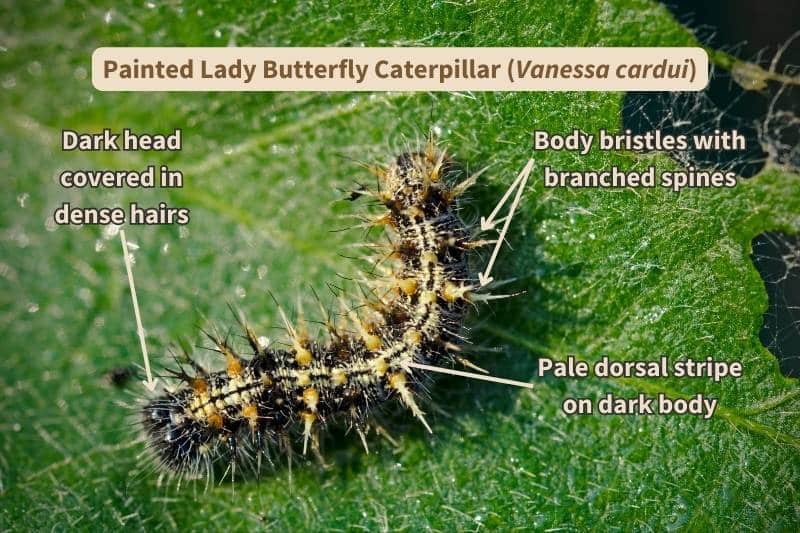
This species’ chrysalis is lavender brown with an iridescent sheen at some light angles and has rows of sharp bumps that run top to bottom. Each chrysalis is about 0.875 inches (22 mm) long and dangles from the leaf or stem of the host plant.
Appearance of Adult Painted Lady Butterflies
Adult Painted Ladies (Vanessa cardui) are medium-sized butterflies, with wing spans around 2.25 inches (57mm). A Painted Lady butterfly’s body is brown and furry; it has pale eyes, white legs, a pointed labial palp that looks like a snout, and black, clubbed antennae tipped in white.
The dorsal (or upper) wing surface of these insects are pinkish orange with dark markings and have small white spots at the top corners of their forewings (known as the “apex”). The middle of the forewing is characterized by jagged, but connected, black markings, while the hindwing show a series of small black spots along the trailing wing margin.
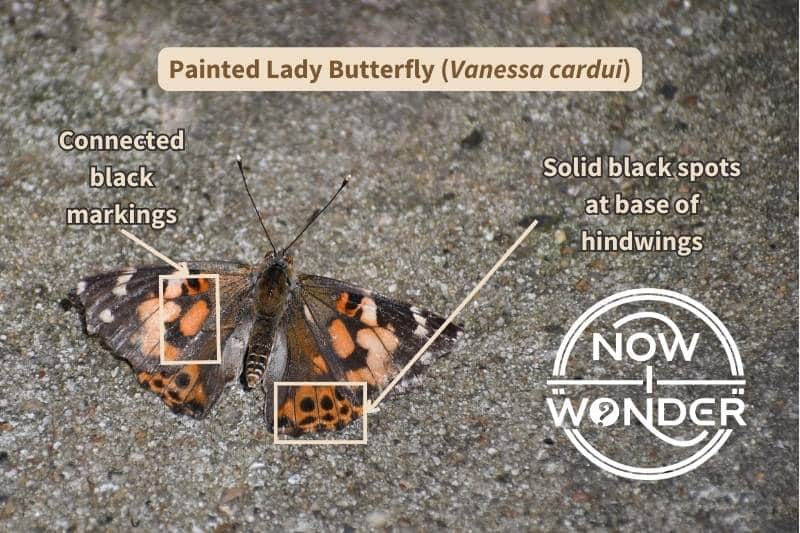
The ventral (or underside) wing surface of these butterflies is tan and brown overall, and is covered with an intricate pattern of pale lines that looks something like a cobweb. But the distinguishing field mark for this species is the line of four prominent eyespots along the trailing edge of the hindwing.

When Can I Find Painted Lady Butterflies in North Carolina?
Painted Lady butterflies (Vanessa cardui) are multi-brooded in North Carolina, producing two or more broods per year during the summer months. Adults arrive in North Carolina around early April and depart for their fall migration to northern Mexico around the end of October, before the first hard frost.
Although adult Painted Ladies drink nectar to obtain calories, they are generalist feeders as caterpillars and eat a wide variety of plants. In fact, they are known to have the longest list of larval host plants of any butterfly species in the world. Unfortunately, this can include important food crops such as corn, soybeans, and alfalfa.
The yearly population of Painted Ladies seen in the eastern United States seems to vary widely- some years they are nearly absent. But during years when their population is high, the caterpillars can be serious pests of agricultural crops and can defoliate entire acres of wild plants such as thistle and globe mallow (Wagner, 2005).
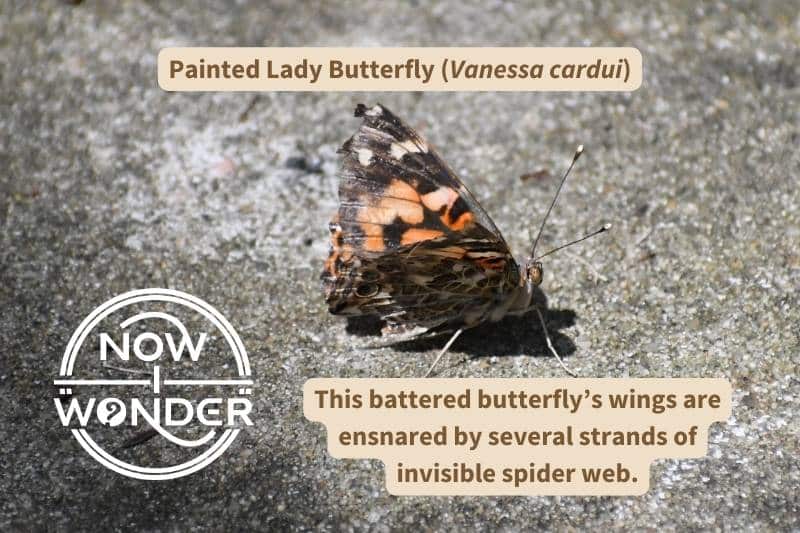
Where to Find Painted Lady Butterflies
Starting around March in North Carolina, look for Painted Lady butterflies (Vanessa cardui) in any open, sunny area, especially meadows or gardens with blooming flowers, and on sunny mountain tops in warm weather.
Painted Ladies are often found close to Red Admiral butterflies (Vanessa atalanta). These two species share leks, which are areas where males of a particular species gather to show off and compete for females (Shapiro, 2007).
But don’t be discouraged if it takes more than a single season to spot one of this butterflies in the wild. While the Painted Lady butterfly (Vanessa cardui) has the broadest worldwide distribution of any butterfly species, individuals can be hard to find in North Carolina sometimes. This is for two reasons.
First, the species is only a summer visitor to the state and individuals re-colonize the entire eastern United States over the course of the summer, so tend to spread thinly across the landscape. Second, the population of Painted Lady butterflies (Vanessa cardui) varies widely year over year. Some years they may be abundant (although still widely distributed) and other they may be virtually absent.
What Do Painted Lady Butterflies Eat?
Painted Lady Butterfly Larval Host Plants
Painted Lady butterfly caterpillars (Vanessa cardui) have the broadest diet of any other known butterfly. Rather than being specialist feeders who rely on a single family of plants for food, these caterpillars can and do feed on nearly any kind of plant, although they do seem to have some favorites.
Painted Lady caterpillars seems to favor the following plants for food:
- Aster family (Asteraceae):
- Burdock (Arctium minus)
- Thistles:
- Horrible Thistle (Cirsium horridulum)
- Bull Thistle (Cirsium vulgare)
- Prickly Sow (Sonchus asper)
- This species is so fond of thistles that another common name is “Thistle Butterfly” (Opler and Malikul, 1992).
- Mallow family (Malvaceae):
- Swamp Rose Mallow (Hibiscus moscheutos)
- Seashore Mallow (Kosteletzkya virginica)
Painted Lady Butterfly Adult Food Plants:
Adult Painted Lady butterflies (Vanessa cardui) drink nectar for calories so visit a wide variety of flowering garden and wild plants.
References
Cuadrado, Mariano. 2021. “Assessing Year-Round Phenology and Reproduction of the Migratory Painted Lady Butterfly, Vanessa Cardui (Lepidoptera: Nymphalidae), in a Mediterranean Area in Southern Spain.” European Journal of Entomology 118: 288-296. doi:https://doi.org/10.14411/eje.2021.029.
Glassberg, Jeffrey, 1999. Butterflies Through Binoculars: The East. New York, NY: Oxford University Press.
Janz, Niklas. 2005. “The Relationship between Habitat Selection and Preference for Adult and Larval Food Resources in the Polyphagous Butterfly Vanessa Cardui (Lepidoptera: Nymphalidae).” Journal of Insect Behavior 18 (6) (11): 767-780. doi:https://doi.org/10.1007/s10905-005-8739-z.
Kelly, Liesl and Diane M. Debinski. 1999. “Effects of Larval Food-Limitation on Vannessa Cardui Linnaeous (Lepidoptera: Nymphalidae).” The American Midland Naturalist 141 (2) (04): 315-322.
Opler, Paul A., and Malikul, Vichai, 1992. Peterson Field Guides: Eastern Butterflies. New York, NY: Houghton Mifflin Company.
Pocewicz, Amy, Penelope Morgan, and Sanford D. Eigenbrode. 2009. “Local and Landscape Effects on Butterfly Density in Northern Idaho Grasslands and Forests.” Journal of Insect Conservation 13 (6) (12): 593-601. doi:https://doi.org/10.1007/s10841-008-9209-7.
Pyle, Robert Michael. 1999. National Audubon Society Field Guide to Butterflies: North America. New York, NY: Alfred A. Knopf.
Shapiro, Arthur. 2007. Field Guide to Butterflies of the San Francisco Bay and Sacramento Valley Regions. Berkeley: University of California Press.
Stefanescu, Constantí, Ferran Páramo, Susanne Åkesson, Marta Alarcón, Anna Ávila, Tom Brereton, Jofre Carnicer, et al. 2013. “Multi-Generational Long-Distance Migration of Insects: Studying the Painted Lady Butterfly in the Western Palaearctic.” Ecography 36 (4) (04): 474-486. doi:https://doi.org/10.1111/j.1600-0587.2012.07738.x.
Wagner, David L., 2005. Princeton Field Guides: Caterpillars of Eastern North America. Princeton, NJ: Princeton University Press.

